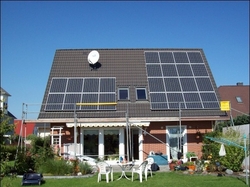Looking at a solar home can really bring solar power down to earth.
I know how fascinating kilowatts, module efficiency, and rated power tolerance can be, but sometimes taking a look at a real solar residential home is even better.
Although the process for installing solar panels will differ slightly depending on where you live, the basics will remain the same.
By hearing the solar stories of others you can get a better idea of whether solar power will work for you.
If it does work for you, then maybe you can pick up a few tips about choosing a qualified solar installer or finding out which solar tax credits gives the most bang for the buck.
After all, it’s smart to learn from your mistakes but it’s even smarter to learn from the mistakes of others (feel free to spread that little pearl of wisdom around).
Not that we’re going to be looking at too many mistakes in this section. As usual we’re going to accentuate the positive while keeping an eye out for any potential pitfalls you might run into with a solar home.
If we provide enough examples of people’s experience with home solar energy, you should be able to pick up quite a bit of information that will apply to your specific situation. Maybe someday we can even feature your solar house as a shining example for others to follow.

On that note, let’s take a look at a real life solar home:
For starters, we’ve got Mike and Patty Capistron of Harwich, Mass.
Mike and Patty were recently in a situation that more and more families can relate to.
In the Cape Cod Times, the Capistrons explain that they have always been interested in solar electric panels but also found them very expensive.
Fortunately, the couple learned that solar financing has come a long way since they built their home 25 years ago. They heard about a company called SunRun that installs solar electric systems on residential rooftops and then sells the power back to the homeowner at a low rate.
Instead of having to spend tens of thousands of dollars on a major solar installation, the Capistrons achieved their solar electric dream for about $3000.
They are now guaranteed a low-price on the electricity their solar panels produce for the next eighteen years and it is estimated that the couple’s solar house could save them $21 000 over the life of the contract.
The moral of this story is that solar power for homes is much more ‘user-friendly’ than it was in the past. If it has been a while since you’ve checked out your solar options, don’t be afraid to take another look.
Between solar power rebates and the new financing options available, a solar power home might be within your reach today, even if it was out of reach in years gone by.
We wish the Capistrons the best of luck with their solar installation and we look forward to bringing you more examples of solar power homes very soon.
